Unit 5 Poems Reading and writing 课件(29张,内嵌音频)人教版(2019)选择性必修 第三册
文档属性
| 名称 | Unit 5 Poems Reading and writing 课件(29张,内嵌音频)人教版(2019)选择性必修 第三册 | 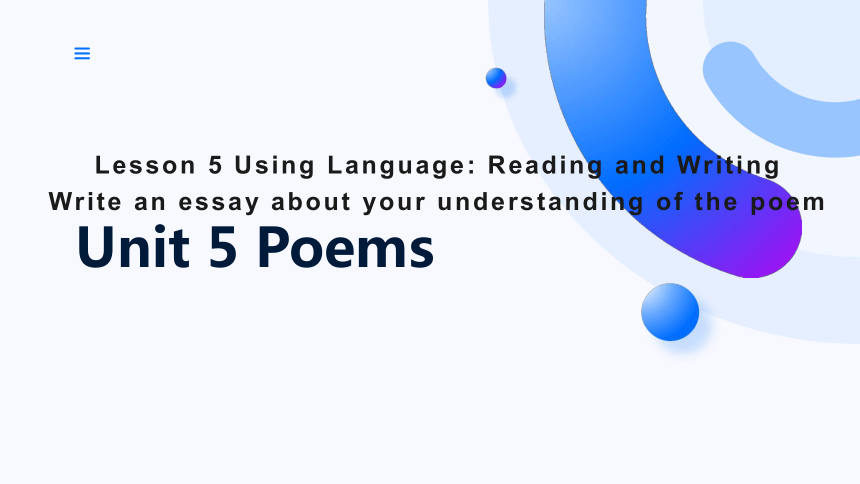 | |
| 格式 | pptx | ||
| 文件大小 | 13.1MB | ||
| 资源类型 | 教案 | ||
| 版本资源 | 人教版(2019) | ||
| 科目 | 英语 | ||
| 更新时间 | 2025-03-05 09:34:49 | ||
图片预览

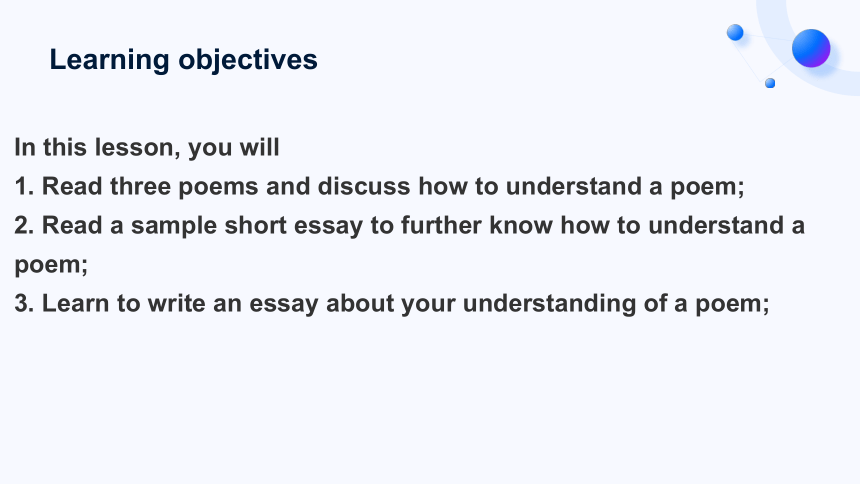

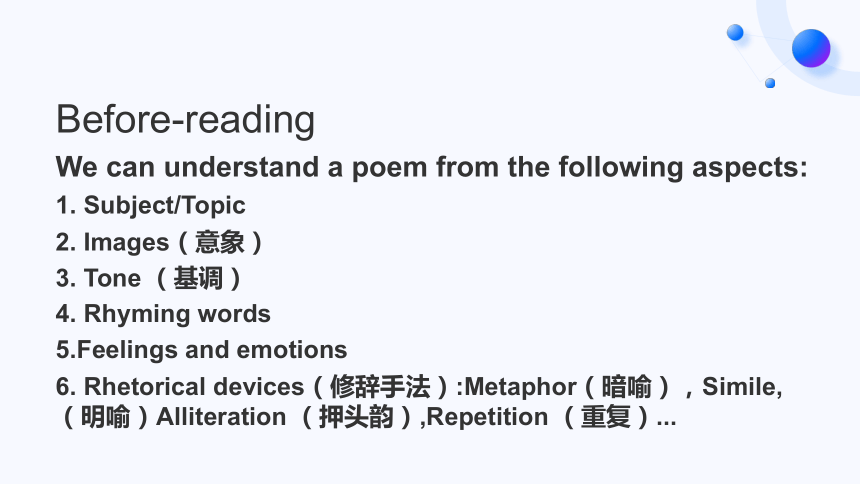
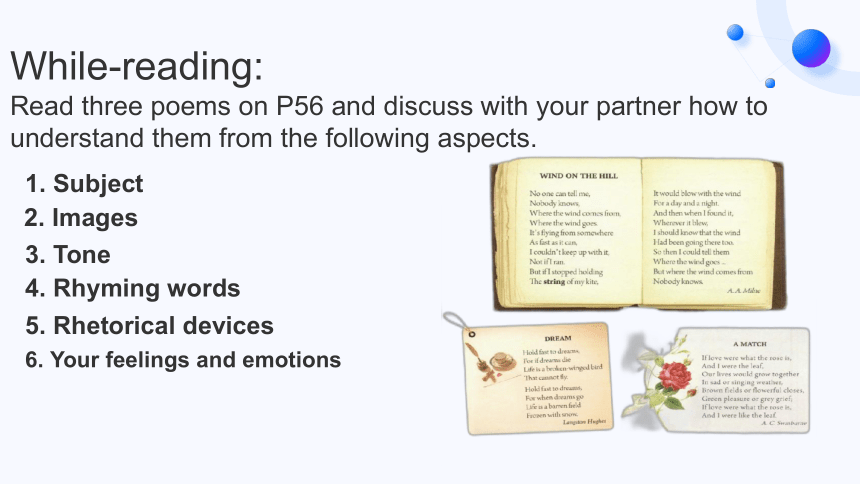
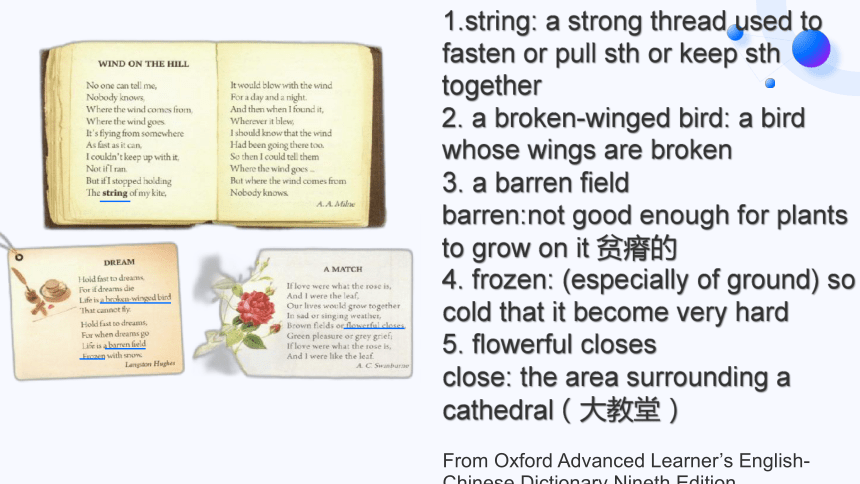

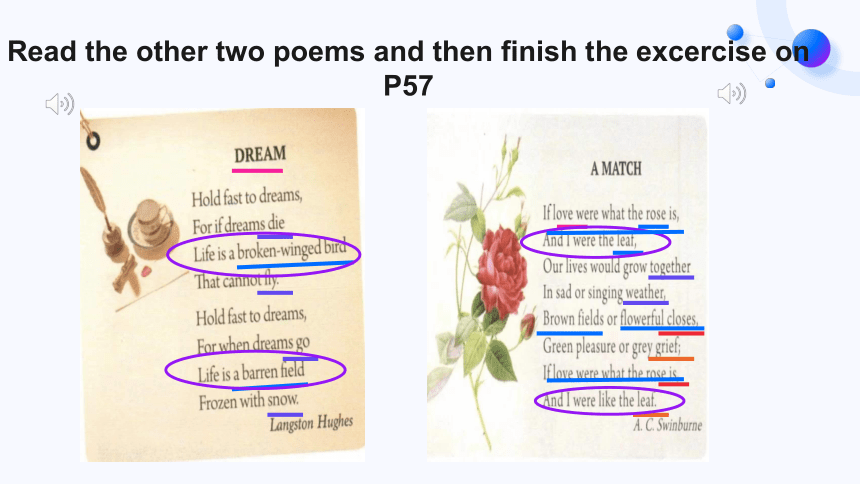
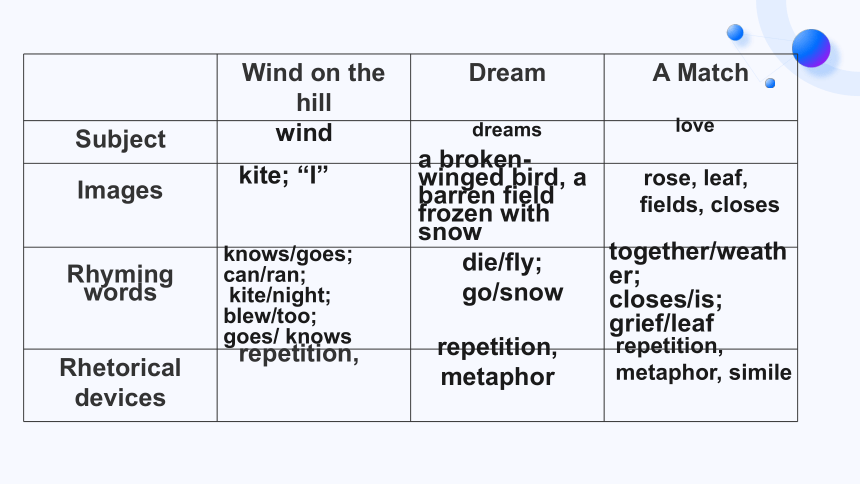
文档简介
(共29张PPT)
Lesson 5 Using Language: Reading and Writing
Write an essay about your understanding of the poem
Unit 5 Poems
In this lesson, you will
1. Read three poems and discuss how to understand a poem;
2. Read a sample short essay to further know how to understand a poem;
3. Learn to write an essay about your understanding of a poem;
Learning objectives
Discuss how to understand a poem with your partner. Make a list of questions that the readers should consider while reading poems.
1. What is the subject of the poem
2. What images(意象) does the poet use
3. What is the tone(基调) of the poem
4. Does the poem use rhyming words(押韵词)
5. How does the poem make you feel
6. What feelings and emotions does the poet try to convey
7. Which rhetorical devices (修辞手法)are used in the poem
Before-reading
We can understand a poem from the following aspects:
1. Subject/Topic
2. Images(意象)
3. Tone (基调)
4. Rhyming words
5.Feelings and emotions
6. Rhetorical devices(修辞手法):Metaphor(暗喻),Simile,(明喻)Alliteration (押头韵),Repetition (重复)...
While-reading:
Read three poems on P56 and discuss with your partner how to understand them from the following aspects.
1. Subject
2. Images
3. Tone
4. Rhyming words
5. Rhetorical devices
6. Your feelings and emotions
1.string: a strong thread used to
fasten or pull sth or keep sth together
2. a broken-winged bird: a bird whose wings are broken
3. a barren field
barren:not good enough for plants to grow on it 贫瘠的
4. frozen: (especially of ground) so cold that it become very hard
5. flowerful closes
close: the area surrounding a cathedral(大教堂)
From Oxford Advanced Learner’s English-Chinese Dictionary Nineth Edition
Let's Read the poem together and undersand it from the aspects we mentioned.
1. Subject
2. Images
4. Rhyming words
5. Rhetorical devices
6. Your feelings and emotions
3. Tone
the wind
kite;the kid “I”
childlike; showing child’s creativity and imagination
knows/goes; can/ran;
kite/night; blew/too; goes/knows
repetition
I feel like I am the child who is curious about the wind and trying to find out where the wind goes creatively
Read the other two poems and then finish the excercise on P57
Wind on the hill Dream A Match
Subject
Images
Rhyming words
Rhetorical devices
wind
kite; “I”
knows/goes; can/ran;
kite/night; blew/too;
goes/ knows
repetition,
dreams
love
a broken-winged bird, a barren field frozen with snow
die/fly;
go/snow
rose, leaf, fields, closes
together/weather;
closes/is; grief/leaf
repetition,
metaphor, simile
repetition,
metaphor
Read the sample short essay on P57 about
how to understand a poem
From what aspects “I” understand
the poem Dream?
Paragraph one
The poem Dream by Langston Hughes is very short with only 8 lines. When I read the pome aloud I can hear that the ends of the second and fourth sentences rhyme--- “die” and “fly”. The last word from the sixth and eighth sentences also rhyme--- “go” and “snow”. These rhyming words sound nice and make the poem pleasing to read.
This paragraph shows that when I enjoy a poem, I notice its form and rhyming words, which can make my reading pleasant.
Useful expressions:
-- The poem is short with only 8 lines.
-- I can hear the ends of second and fourth sentences rhyme.
-- The rhyming words sound nice and make the poem pleasing to read.
When I close my eyes, I can see different images from the poem. For example, I can see two hands being held. I can see a bird flying in the sky. I can see a field and I can imagine what it looks like with lots of snow. I start to feel cold when I read these lines!
This paragraph shows that the images in the poem will communicate certain feelings in the reader.
Useful expressions:
-- I can see different images from the poem.
-- I can see two hands being held.
-- I start to feel ... when I read these lines.
Paragraph Two
I learnt a new phrase, “hold fast”, which means to hold onto something. “Barren” is also a new word to me, which means empty.
This paragraph shows that when I enjoy a poem, I will encounter some unfamiliar expressions which will enlarge the vocabulary.
Useful expressions:
-- I learnt a new phrase, “hold fast”, which means...
Paragraph Three
I think the poet is giving us advice. He wants us to keep dreaming, because life is much better when we dream and have something to look forward to.
This paragraph shows that I will learn something from the poem, which means the poem conveys certain meaning to the reader.
Useful expressions:
-- I think the poet is giving us advice.
Paragraph Four
After-reading: Brief Summary
When we write an essay about how to understand a poem, we usually do it from the following aspects:
Poetic form-- lines; rhyming words
Poetic subject -- sth or sb the poem centers on
Poetic language-- images; rhetorical devices; new expressions;
Poetic meaning -- tone; feelings and emotions conveyed
Poetic form:
The poem is the translation of a Chinese poem in Tang Dynasty, which has a regular number of lines.
The poem follows special pattern of rhythm and rhyme, with the ends of the first and second lines rhyming...
The poem belongs to prose poetry(散文诗) with no regular rhythm and rhyming words.
More reference expressions for writing:
More reference expressions for writing:
Poetic subject:
The poet centers around the relationship between..., which can arouse the readers’ interest.
The poet depicts(描绘) / describes very imaginative scenes in which kids are...
The poem is focused on... , which is familiar to the common people. However, it can ...
More reference expressions for writing:
Poetic language:
The image of... brings a feeling of...
When I see the image, I feel like I were ... , who...
Repetition of the first two lines and the last two lines conveys a strong feeling of ... to the readers.
The poet compares...with..., which enables me to be immersed in the world depicted in the poem.
Two images are employed in the poem, which is sure to arouse the readers’...
More reference expressions for writing:
Poetic meaning:
...reminded me of...
The poem is written from a parent’s /... perspective.
The poet was filled with ... as he/she wrote...
The poet means to convey a message to the readers that...
The poet employs(采用) the language that can create an optimistic tone of the poem.
The tone of the poem is very encouraging and helpful, which can enlighten(启发) the readers.
The poem provides the inspiration for me to handle my adolescent(青春期的) problems.
The reason why I love this poem is that...
Write an essay about your understanding of the poem
Part One: read the poem and get to know its poetic form and subject
Part Two: understand the poem from other aspects
I. focuses on the poetic language including images, rhetorical devices or the new expressions.
II. centers on the poetic meaning like the tone, the emotions the poem conveys and your feelings about it or your reasons why you like it
Read the poem On Children on P95 and write an essay about your understanding of the poem
Before writing, think about the following questions:
1. What's your relationship between your parents and you like
2. What is a proper simile or metaphor to describe the relationship between your parents and you
1.Some students tell me that the relationship between his parents and him is close and harmonious, while others say that the relationship is not good and close.
2. The student, who holds the positive idea about the relationship compares his parents and him to the lighthouse and the ship to describe the relationship, but on the other hand, the student, who has the negative idea uses the rider and the horse to describe the relationship.
Let’s get to know some words and expressions in the poem.
1. dwell in: to live somewhere
2. strive: try very hard to achieve sth
3. tarry: stay in a place; to delay coming or going from a place 逗留;耽搁
4. archer: a person who shoots with a bow and arrows 弓箭手
5. infinite: without limits; without end 无限的;
6. might: great strength, energy or power
7. stable: firmly fixed; not likely to move, change or fail稳定的;牢固的
From Oxford Advanced Learner’s English-Chinese Dictionary
Nineth Edition
Understand the poem from different aspects
1. Poetic Form:
prose poetry with no regular rhythm or rhyming words
2. Poetic Subject:
relationship between parents and children
3. Poetic Language:
Images:
Rhetorical devices:
4. Poetic Meaning:
Tone:
Feelings and emotions:
bows, arrows and the archer
metaphor; parallelism
advice-giving; persuasive; helpful
giving helpful and constructive suggestions to
parents about how to handle the relationship
with children; very persuasive;
The poem On Children describes parents’ relationship to their children. The poet is saying that your children are not your property, and that they are individual people with their own thoughts and souls that should be respected. Parents should not try and make their children exactly like themselves. The poet compares a parent and child to a bow and arrow to describe this relationship. The parent is the bow, which should remain stable and reliable, and the child is the arrow, which one should make sure is fired straight and true.
I think the poet was filled with love for his children when he wrote this, and also knowledge that he had come to understand himself. The reason why I love this poem is that I think it will help people become better parents by showing them that it is better not to control their children too much. They should be there to look after them when they need it and guide them on their way.
Sample writing:
In this lesson, we have learned:
1. How to understand a poem from different aspects.
2. How to write an essay about your understanding of the poem.
Summary
Homework
1. Share the poem On Children and your essay with your parents.
2. Read the poem The Gift on P95 and understand it from the aspects we have mentioned.
Lesson 5 Using Language: Reading and Writing
Write an essay about your understanding of the poem
Unit 5 Poems
In this lesson, you will
1. Read three poems and discuss how to understand a poem;
2. Read a sample short essay to further know how to understand a poem;
3. Learn to write an essay about your understanding of a poem;
Learning objectives
Discuss how to understand a poem with your partner. Make a list of questions that the readers should consider while reading poems.
1. What is the subject of the poem
2. What images(意象) does the poet use
3. What is the tone(基调) of the poem
4. Does the poem use rhyming words(押韵词)
5. How does the poem make you feel
6. What feelings and emotions does the poet try to convey
7. Which rhetorical devices (修辞手法)are used in the poem
Before-reading
We can understand a poem from the following aspects:
1. Subject/Topic
2. Images(意象)
3. Tone (基调)
4. Rhyming words
5.Feelings and emotions
6. Rhetorical devices(修辞手法):Metaphor(暗喻),Simile,(明喻)Alliteration (押头韵),Repetition (重复)...
While-reading:
Read three poems on P56 and discuss with your partner how to understand them from the following aspects.
1. Subject
2. Images
3. Tone
4. Rhyming words
5. Rhetorical devices
6. Your feelings and emotions
1.string: a strong thread used to
fasten or pull sth or keep sth together
2. a broken-winged bird: a bird whose wings are broken
3. a barren field
barren:not good enough for plants to grow on it 贫瘠的
4. frozen: (especially of ground) so cold that it become very hard
5. flowerful closes
close: the area surrounding a cathedral(大教堂)
From Oxford Advanced Learner’s English-Chinese Dictionary Nineth Edition
Let's Read the poem together and undersand it from the aspects we mentioned.
1. Subject
2. Images
4. Rhyming words
5. Rhetorical devices
6. Your feelings and emotions
3. Tone
the wind
kite;the kid “I”
childlike; showing child’s creativity and imagination
knows/goes; can/ran;
kite/night; blew/too; goes/knows
repetition
I feel like I am the child who is curious about the wind and trying to find out where the wind goes creatively
Read the other two poems and then finish the excercise on P57
Wind on the hill Dream A Match
Subject
Images
Rhyming words
Rhetorical devices
wind
kite; “I”
knows/goes; can/ran;
kite/night; blew/too;
goes/ knows
repetition,
dreams
love
a broken-winged bird, a barren field frozen with snow
die/fly;
go/snow
rose, leaf, fields, closes
together/weather;
closes/is; grief/leaf
repetition,
metaphor, simile
repetition,
metaphor
Read the sample short essay on P57 about
how to understand a poem
From what aspects “I” understand
the poem Dream?
Paragraph one
The poem Dream by Langston Hughes is very short with only 8 lines. When I read the pome aloud I can hear that the ends of the second and fourth sentences rhyme--- “die” and “fly”. The last word from the sixth and eighth sentences also rhyme--- “go” and “snow”. These rhyming words sound nice and make the poem pleasing to read.
This paragraph shows that when I enjoy a poem, I notice its form and rhyming words, which can make my reading pleasant.
Useful expressions:
-- The poem is short with only 8 lines.
-- I can hear the ends of second and fourth sentences rhyme.
-- The rhyming words sound nice and make the poem pleasing to read.
When I close my eyes, I can see different images from the poem. For example, I can see two hands being held. I can see a bird flying in the sky. I can see a field and I can imagine what it looks like with lots of snow. I start to feel cold when I read these lines!
This paragraph shows that the images in the poem will communicate certain feelings in the reader.
Useful expressions:
-- I can see different images from the poem.
-- I can see two hands being held.
-- I start to feel ... when I read these lines.
Paragraph Two
I learnt a new phrase, “hold fast”, which means to hold onto something. “Barren” is also a new word to me, which means empty.
This paragraph shows that when I enjoy a poem, I will encounter some unfamiliar expressions which will enlarge the vocabulary.
Useful expressions:
-- I learnt a new phrase, “hold fast”, which means...
Paragraph Three
I think the poet is giving us advice. He wants us to keep dreaming, because life is much better when we dream and have something to look forward to.
This paragraph shows that I will learn something from the poem, which means the poem conveys certain meaning to the reader.
Useful expressions:
-- I think the poet is giving us advice.
Paragraph Four
After-reading: Brief Summary
When we write an essay about how to understand a poem, we usually do it from the following aspects:
Poetic form-- lines; rhyming words
Poetic subject -- sth or sb the poem centers on
Poetic language-- images; rhetorical devices; new expressions;
Poetic meaning -- tone; feelings and emotions conveyed
Poetic form:
The poem is the translation of a Chinese poem in Tang Dynasty, which has a regular number of lines.
The poem follows special pattern of rhythm and rhyme, with the ends of the first and second lines rhyming...
The poem belongs to prose poetry(散文诗) with no regular rhythm and rhyming words.
More reference expressions for writing:
More reference expressions for writing:
Poetic subject:
The poet centers around the relationship between..., which can arouse the readers’ interest.
The poet depicts(描绘) / describes very imaginative scenes in which kids are...
The poem is focused on... , which is familiar to the common people. However, it can ...
More reference expressions for writing:
Poetic language:
The image of... brings a feeling of...
When I see the image, I feel like I were ... , who...
Repetition of the first two lines and the last two lines conveys a strong feeling of ... to the readers.
The poet compares...with..., which enables me to be immersed in the world depicted in the poem.
Two images are employed in the poem, which is sure to arouse the readers’...
More reference expressions for writing:
Poetic meaning:
...reminded me of...
The poem is written from a parent’s /... perspective.
The poet was filled with ... as he/she wrote...
The poet means to convey a message to the readers that...
The poet employs(采用) the language that can create an optimistic tone of the poem.
The tone of the poem is very encouraging and helpful, which can enlighten(启发) the readers.
The poem provides the inspiration for me to handle my adolescent(青春期的) problems.
The reason why I love this poem is that...
Write an essay about your understanding of the poem
Part One: read the poem and get to know its poetic form and subject
Part Two: understand the poem from other aspects
I. focuses on the poetic language including images, rhetorical devices or the new expressions.
II. centers on the poetic meaning like the tone, the emotions the poem conveys and your feelings about it or your reasons why you like it
Read the poem On Children on P95 and write an essay about your understanding of the poem
Before writing, think about the following questions:
1. What's your relationship between your parents and you like
2. What is a proper simile or metaphor to describe the relationship between your parents and you
1.Some students tell me that the relationship between his parents and him is close and harmonious, while others say that the relationship is not good and close.
2. The student, who holds the positive idea about the relationship compares his parents and him to the lighthouse and the ship to describe the relationship, but on the other hand, the student, who has the negative idea uses the rider and the horse to describe the relationship.
Let’s get to know some words and expressions in the poem.
1. dwell in: to live somewhere
2. strive: try very hard to achieve sth
3. tarry: stay in a place; to delay coming or going from a place 逗留;耽搁
4. archer: a person who shoots with a bow and arrows 弓箭手
5. infinite: without limits; without end 无限的;
6. might: great strength, energy or power
7. stable: firmly fixed; not likely to move, change or fail稳定的;牢固的
From Oxford Advanced Learner’s English-Chinese Dictionary
Nineth Edition
Understand the poem from different aspects
1. Poetic Form:
prose poetry with no regular rhythm or rhyming words
2. Poetic Subject:
relationship between parents and children
3. Poetic Language:
Images:
Rhetorical devices:
4. Poetic Meaning:
Tone:
Feelings and emotions:
bows, arrows and the archer
metaphor; parallelism
advice-giving; persuasive; helpful
giving helpful and constructive suggestions to
parents about how to handle the relationship
with children; very persuasive;
The poem On Children describes parents’ relationship to their children. The poet is saying that your children are not your property, and that they are individual people with their own thoughts and souls that should be respected. Parents should not try and make their children exactly like themselves. The poet compares a parent and child to a bow and arrow to describe this relationship. The parent is the bow, which should remain stable and reliable, and the child is the arrow, which one should make sure is fired straight and true.
I think the poet was filled with love for his children when he wrote this, and also knowledge that he had come to understand himself. The reason why I love this poem is that I think it will help people become better parents by showing them that it is better not to control their children too much. They should be there to look after them when they need it and guide them on their way.
Sample writing:
In this lesson, we have learned:
1. How to understand a poem from different aspects.
2. How to write an essay about your understanding of the poem.
Summary
Homework
1. Share the poem On Children and your essay with your parents.
2. Read the poem The Gift on P95 and understand it from the aspects we have mentioned.
